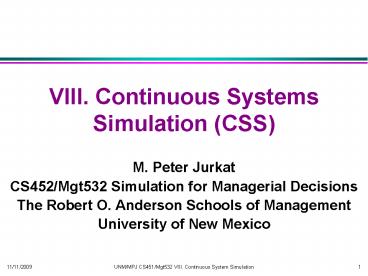VIII' Continuous Systems Simulation CSS PowerPoint PPT Presentation
1 / 13
Title: VIII' Continuous Systems Simulation CSS
1
VIII. Continuous Systems Simulation (CSS)
- M. Peter Jurkat
- CS452/Mgt532 Simulation for Managerial Decisions
- The Robert O. Anderson Schools of Management
- University of New Mexico
2
How Various Models are Studied
3
Approach
- Continuous models simulate situations which could
be changing all the time usually described by
differential equations (DEs) cannot calculate
with DEs - Approximate with Difference Equations (also
DiffEs) - Usually deterministic stochastic DE/DiffEs
advanced topic - Basic variable (time, distance, ) with constant
step size and/or time/distance/ dependent inputs
and/or parameters - Often unknown and/or impractical analytic
solutions - Solved by simulation - Yields function which specifies state variables
at all times/distances/ performance measure is
a function of state variables - Studied by DOE on parameter values
4
CSS Examples
- Calculating space flight orbits trajectories due
strength/direction of engine boosts and gravity
of nearby heavenly bodies (sun, planets, moons,
etc.) - Calculating response of a controlled element due
to control changes (e.g., machine tool path,
flight simulators, refineries, atomic energy
plants) - Calculating best bid prices for financial
options based on Black-Scholes payoff formulation
(stochastic differential equations involving
strike price, time, and price volatility/s.d.)
5
CSS Example
- Fluid flow through complicated spaces
- Similar to flow though jet engines
- From http//www.uk.comsol/products/chem/applicatio
ns.php
6
CSS Example
- Finite Element Modeling to determine extend of
trauma due to blows - Mesh lines between nodes interpreted as springs
- Yields deformation vs. applied forces
- From Krabbel and Miller (?) DEVELOPMENT OF A
FINITE ELEMENT MODEL OF THE HEAD USING THE
VISIBLE HUMAN DATA, web site of Orthopedic
Biomechanics Laboratory, Harvard Medical School,
Boston
7
Difference Equations
- Many models described by difference equations
- DEs are simulated by making the continuous
underlying variable (time, distance) discrete by
approximating continuous movement at set
intervals, usually small - Example Recall Example 2.4 (pp45-47) and
Banks4Example2-4InvCosts.gps - unless each
withdrawal and replenishment is to be tracked
individually at its exact time, inventory systems
can be well approximated by difference equations
on a daily/monthly/yearly basis - Balance equations at time period t is
- inventorylevelt inventorylevelt-1
withdrawalst replenishmentst - Need starting inventory level at time t 0, then
get inventory level1, then inventory level2 ,
8
Order of Difference Equations
- Level of largest delay from current time step in
DE is order of system - For instance yt yt-3 is a 3rd order system
with no term has larger differences - 1st order yt cyt-1
- 2nd order yt 2c(yt-1 yt-2)
- See DifferenceEquations.xls
9
Population Dynamics
- Modern version is called the Leslie Model, after
a quantitative biologist, and based on life
tables developed in the 1700s by the Bernoullis,
Euler, Halley, etc. - Now formalized (e.g., Feller (1968) Intro to Prob
Theory and its Apps) - Basis of the entire life insurance industry
- Can also be applied to other populations, i.e.,
any items that replicate themselves (e.g.,
invested money)
10
Simplest Model
- Let At number of adult breeding pairs during
period t (often a generation) - Let Yt number of young, non-breeding pairs
during period t - Then Yt1 f1Yt f2At
- At1 sYt
- where f1 and f2 are fertility rates and s is the
survival rate - All adults die out in each generation (at least
are no longer involved in reproduction) - Too simplistic fertility depends on age within
reproductive periods need to introduce cohorts
11
Multi-Cohort Leslie Model
- Assume k population cohorts subgroups
distinguished by different reproduction and/or
survival rates indexed by i 1, 2, , k - Let Xi,t number of units is cohort k at time t
- Then X1,t1 f1X1,t f2X2,t fkXk.t
- X2,t1 s1X1.t
- Xk,t1 skXk,t
- where fi are fertility rates and si are survival
rates - Needs to be augmented by any in- and
out-migration (e.g., inventory model)
12
Examples of Population CohortsCull, Flavine, and
Robson (2005) Difference Equations From Rabbits
to Chaos, Springer, ISBN 9780387232348
13
Assignment
- Use DifferenceEquations.xls to characterize both
Leslie models and both the 1st and 2nd order
equations for various values of their parameters.
This can be a group effort. - Try various values, both positive and negative,
and show the plots of the solution that support
your observations and conclusions. In
particular, try to find values that make a
qualitative difference.

